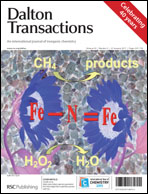Two laterally non-symmetric aza-oxa cryptands have been derivatized with the electron-withdrawing fluorophore, 7-nitrobenz-2-oxa-1,3-diazole to obtain the corresponding mono-, bis- and tris-products. In each case, no appreciable emission is observed when the fluorophore is excited due to an efficient photoinduced intramolecular electron transfer (PET) from the lone pair on nitrogen present in the bridges. In the presence of a number of transition and heavy metal ions, their emission characteristics change. The electron-withdrawing ability of the fluorophore drastically alters the binding ability of the cryptand such that Hg(II) affords largest enhancement of fluorescence. In contrast, mono-, bis- and tris-anthryl (electron-donating) derivatives of these cryptands do not exhibit any selectivity towards Hg(II) and affords low fluorescence enhancement. Also, the difference in cavity dimension of the o-cryptand and m-cryptand plays a crucial role in terms of selectivity.
You have access to this article
 Please wait while we load your content...
Something went wrong. Try again?
Please wait while we load your content...
Something went wrong. Try again?


 Please wait while we load your content...
Please wait while we load your content...